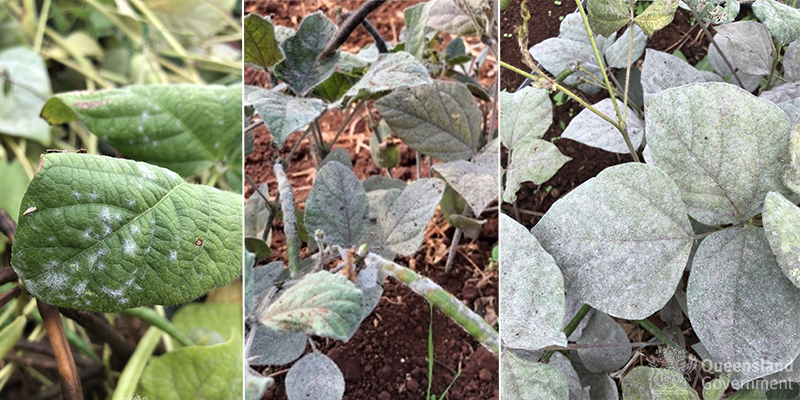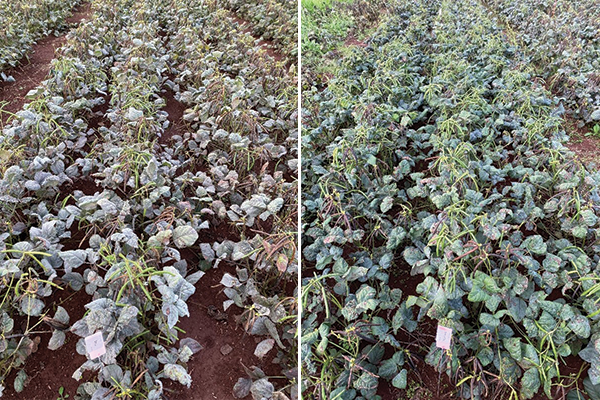Powdery mildew is a fungal disease that is commonly seen each cropping season in most mungbean paddocks in Australia. In Queensland and northern New South Wales, disease outbreaks usually occur from early autumn in the summer planted crops, with epidemics typically developing as soon as temperatures drop.
Initial symptoms are easy to recognise: small whitish, powdery spots on the upper and lower leaf surfaces, usually appearing first in the lower canopy on older leaves. These spots then enlarge, coalesce, and can cover large areas or even the entire surface of infected leaves. Petioles, stems, and green pods may also become infected. If environmental conditions are conducive to the disease, the entire canopy could be covered with intensively sporulating powdery mildew mycelium.

Powdery mildew on mungbean – initial spots, symptoms on pods and whole canopy infection. Photos: Lisa Kelly, DPI
Initial symptoms
Recent research at the University of Southern Queensland (UniSQ) and Queensland Department of Primary Industries (DPI) indicated that the disease could reduce mungbean yields by up to 40% if crops are infected prior to flowering, followed by weather conditions conducive to disease development, and no fungicides are applied.
In contrast, infections that appear after flowering usually do not have a considerable impact on grain yield. Sowing early in summer should allow the crop to reach the green pod stage before powdery mildew becomes widespread in paddocks in most seasons. Early sowing could therefore be the most effective way of managing this disease without using fungicide treatments.
The disease is caused by two powdery mildew species, Podosphaera xanthii and Erysiphe vignae in Australia. These two species are quite different under the microscope but cannot be distinguished based on the symptoms found on mungbean. Both powdery mildews are able to infect a number of other plant species, and some weeds could be sources of infection (in addition to volunteer mungbean and black gram plants).
All powdery mildew fungi require a living plant host to survive. These pathogens will not survive in soil, crop residue, or in seed between cropping seasons, so ensuring good field hygiene is also an essential part of managing this disease between seasons.
Varietal susceptibility
All commercially available mungbean varieties are susceptible to powdery mildew to some extent, so fungicide applications may be needed for powdery mildew management. Jade-AU* and Crystal* are considered moderately susceptible to powdery mildew infection, while Opal-AU* is rated as moderately resistant. Two recently introduced varieties, Green Dragon* and Green Taipan* are also often infected with powdery mildew.
*PBR varieties
Fungicide management
Currently registered or permitted fungicide products for the management of powdery mildew in mungbeans contain 430 g/L tebuconazole (for example, Orius® 430 SC), or a mixture of 222 g/L azoxystrobin and 370 g/L tebuconazole (Veritas® Opti). Tebuconazole is a demethylase inhibitor (DMI) from the Group 3 mode of action (MoA) fungicides; azoxystrobin is a quinone outside inhibitor (Qol) from Group 11.
The conventional recommendation for managing mungbean powdery mildew is to spray fungicide at the first sign of disease followed by a second fungicide treatment two weeks later. Some growers apply a preventive fungicide with their first insecticide spray (before there is any sign of powdery mildew), however replicated field trials have shown that applying fungicide products with two actives belonging to two different modes of actions when powdery mildew is found in the crop, provided better control than preventive sprays.
Managing mungbean powdery mildew with fungicides is not always economical.
A Decision Support Tool, the PowderyMildewMBM app, is available from both the Google Play and Apple App Stores to assist with fungicide application decisions. Free and easy to use, the PowderyMildewMBM app calculates the most likely estimates of financial return (if any) from each planned spray. Calculations are based on application costs and expected efficacy (e.g. aerial versus ground sprays); expected yields and grain price; crop stage; and weather forecasts. You can run different scenarios for any paddock and compare the expected monetary returns for one or two sprays, or no spray at all.
The app supports the principle ‘if it doesn’t pay, don’t spray’. Developed based on powdery mildew severity and grain yield data obtained from 16 disease management trials carried out in Queensland and New South Wales from 2011 to 2019, its outputs have been recently supported by an additional seven replicated trials and six demonstration sites in the Darling Downs, South Burnett, and Western Downs regions of Queensland.
The DNA markers of resistance to both tebuconazole and azoxystrobin, the two actives of the fungicide products that are currently available against the disease, have already been detected by UniSQ in mungbean powdery mildew populations sampled in southern Queensland. So, while the available fungicide products still work against this disease, always follow the principles of the Australian Fungicide Resistance Extension Network when applying fungicides to preserve their efficacy as long as possible.

Heavy powdery mildew in an unsprayed plot (left) compared to infection in a plot (right) sprayed twice with a fungicide product with two actives belonging to different mode of action (MoA) groups. Photos: Kirsty Owen, University of Southern Queensland.
Powdery mildew is favoured by cool (20-24ºC), humid weather. The increased humidity due to frequent rain in the current 2025 season may increase the likelihood of powdery mildew infecting crops earlier than expected. Once infected, symptoms can progress quickly. Closely monitor crops for disease and use the DST to assist in fungicide application decisions.
If you would like confirmation of disease identification or pathogen presence, samples can be submitted for diagnostics as part of GRDC-DPI projects.
Further resources
- Hold the spray when it comes to powdery mildew. GroundCover article (May-June 2024)
- Mungbean powdery mildew; fungicide sensitivities and management for Queensland growers. GRDC Podcast (Feb 2024)
- Management of mungbean powdery mildew. GRDC Update Paper (July 2024)

